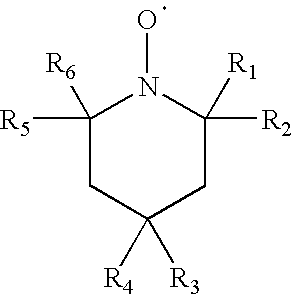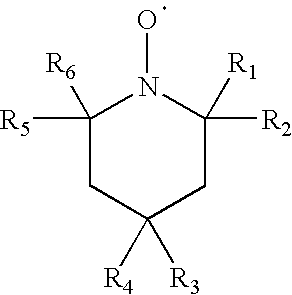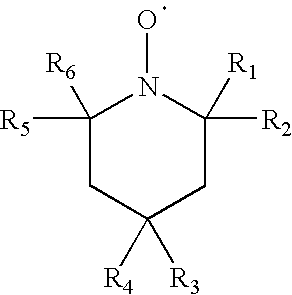Heat transferable material for improved image stability
- Summary
- Abstract
- Description
- Claims
- Application Information
AI Technical Summary
Benefits of technology
Problems solved by technology
Method used
Image
Examples
embodiment 1
[0077]A heat transferable donor element comprising a polymeric support, the support having at least one portion thereof coated with a heat transferable material comprising a heat transferable polymeric binder and a light stabilizer that is an N-oxyl radical that is derived from a hindered amine, the N-oxyl radical having the following formula:
wherein R1, R2, R5, and R6 are each independently selected from a straight or branched C1-C6 alkyl or alkene, and R3 and R4 are each independently selected from H, OH, OR, COOH, or COOR, wherein R is a straight or branched C1-C6 alkyl or alkene, and having a molecular weight of 600 or less.
embodiment 2
[0078]The element of embodiment 1 comprising at least one protective overcoat patch.
embodiment 3
[0079]The element of embodiment 1 or 2 wherein the N-oxyl radical light stabilizer is:
PUM
| Property | Measurement | Unit |
|---|---|---|
| Fraction | aaaaa | aaaaa |
| Fraction | aaaaa | aaaaa |
| Fraction | aaaaa | aaaaa |
Abstract
Description
Claims
Application Information
 Login to View More
Login to View More - R&D
- Intellectual Property
- Life Sciences
- Materials
- Tech Scout
- Unparalleled Data Quality
- Higher Quality Content
- 60% Fewer Hallucinations
Browse by: Latest US Patents, China's latest patents, Technical Efficacy Thesaurus, Application Domain, Technology Topic, Popular Technical Reports.
© 2025 PatSnap. All rights reserved.Legal|Privacy policy|Modern Slavery Act Transparency Statement|Sitemap|About US| Contact US: help@patsnap.com



